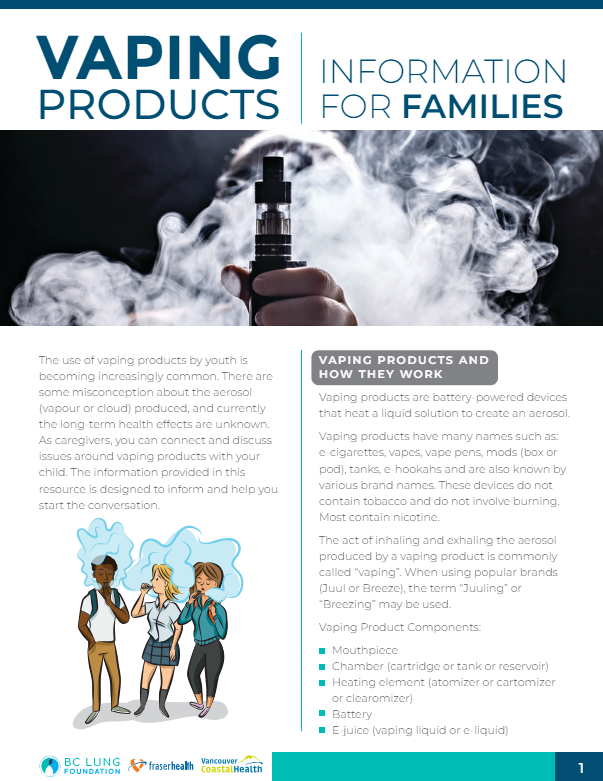Tobacco, Vaping & Cannabis

Smoking and use of tobacco products, including e-cigarettes (vaporizers), cigars and smokeless tobacco, cause or worsen numerous diseases and conditions.
Every year, an estimated 48,000 Canadians die from tobacco use and exposure to secondhand smoke, making it the leading cause of preventable death in this country. Tragically, each day thousands of kids still pick up a vaping (e-cigarette) or tobacco product for the first time.

Quit Smoking & Vaping through QuitNow
QuitNow is a free program for British Columbians looking to quit or reduce tobacco and e-cigarette use, delivered by the BC Lung Foundation on behalf of the Government of British Columbia.

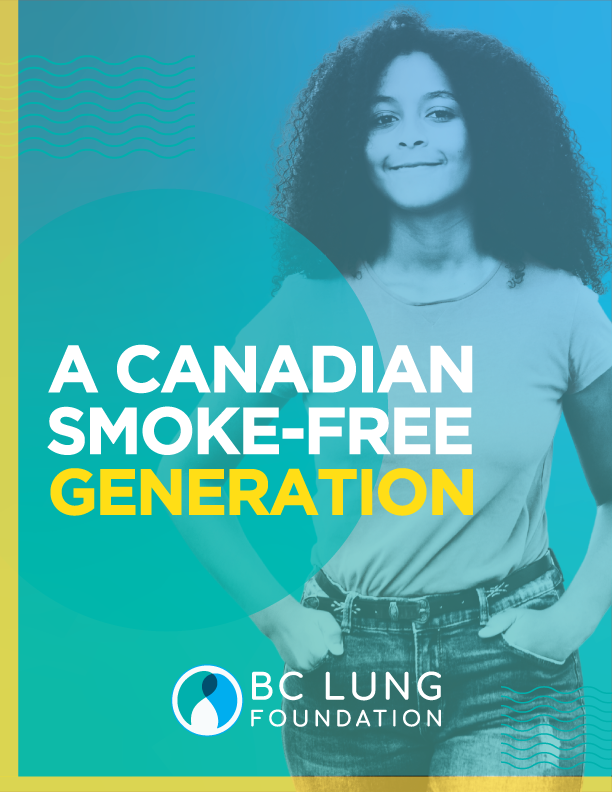
Smoke-Free Generation
Our vision: Make British Columbia the first province in Canada where future generations will never be able to buy commercial tobacco or nicotine products.
There is no safe level of commercial tobacco or nicotine use. The Smoke-Free Generation (SFG) proposal bans the sale of tobacco and nicotine (vaping) products to anyone born on or after a specific date. It increases the legal age at which people can purchase tobacco and vaping products every year. Over time, it will create a generation of young people who have never been able to buy tobacco or vaping products, effectively phasing out the sale and use of tobacco and nicotine.
Vaping Health Education Toolkits for Parents & Teachers
BC Lung partnered with Fraser Health Authority to develop youth health education vaping resources. Their objective is to raise awareness and increase the knowledge of educators, and help guide youth towards making informed decisions.
Intended for teachers, health care professionals and parents, the toolkits below (Clearing the Cloud (Grades 5-7) and Exploring the Cloud (Grades 8-10)) include PowerPoint presentations with integrated interactive activities and concise video content on the known health risks of vaping.
Grades 5 – 7

Clearing the Cloud Presentation Toolkit
This kit includes:
- PowerPoint presentation
- Talking notes for the presenter
- Fill-in-the-blank activity
- BINGO game
Grades 8 – 10

Exploring the Cloud Presentation Toolkit
This kit includes:
- PowerPoint presentation (English & French)
- Talking notes for the presenter
- Math activity
- ‘What’s in E-Juice?’ handout
For Teachers

Information for Teachers
Intended for educators including teachers and health care providers, this resource addresses additional questions raised by educators not covered elsewhere. It is meant to complement the PowerPoint Presentation by providing supplemental information to help teachers address the topic with students.
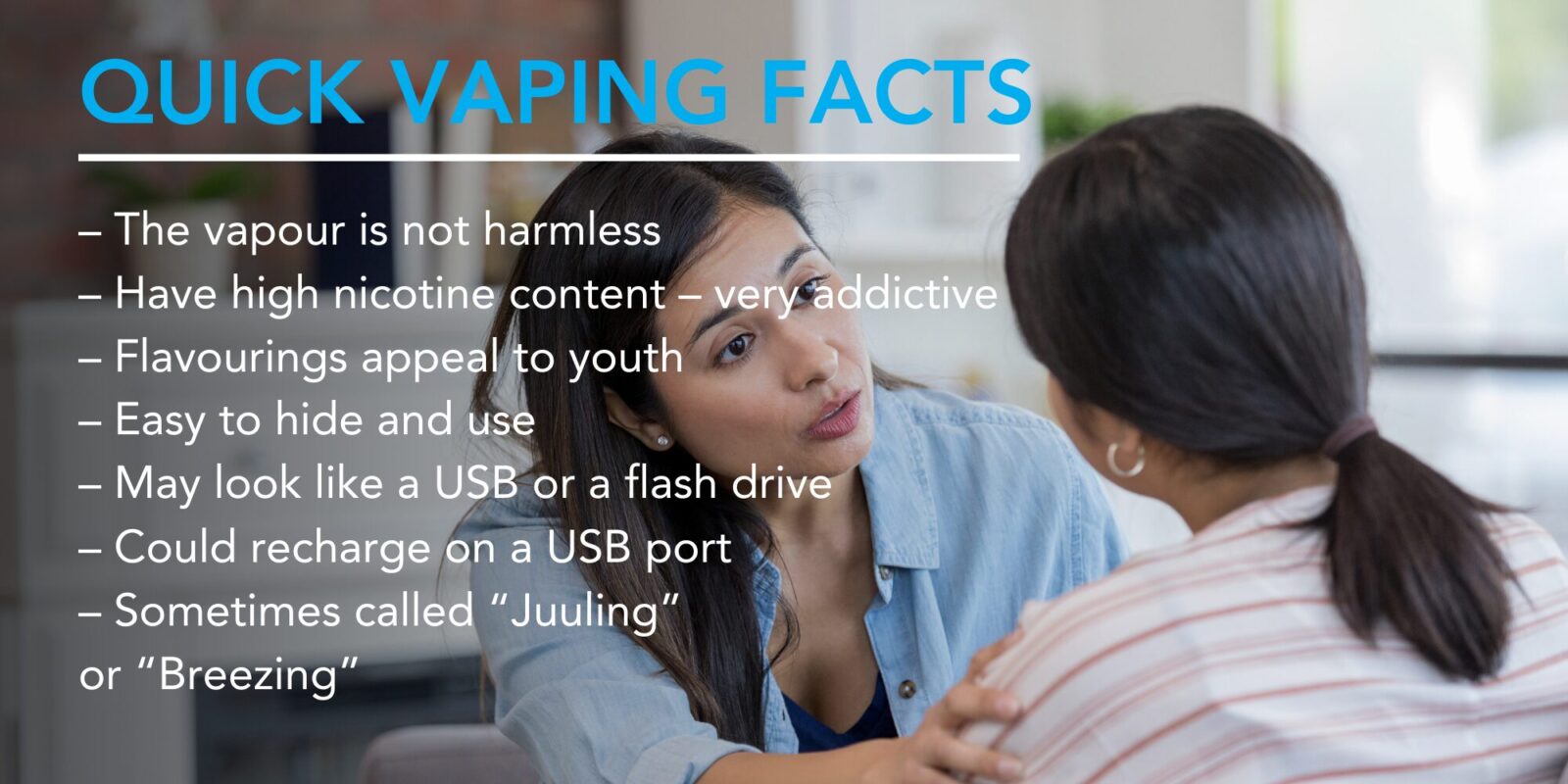
Start a conversation with your child

Have honest conversations with your child.
If you use tobacco or vaping products, this is an opportunity to discuss the risks, any regrets, difficulties, and health effects you may have experienced.
Be patient and ready to listen when taking part in conversations with youth. Try to avoid criticism and encourage an open dialogue. Remember to keep the discussion going, and do not expect to make an impact with just one conversation.
Here are some questions your child may ask about vaping products along with suggestions on how to respond:
“Why shouldn’t I vape?”
Researchers have found that vaping products contain toxic and addictive ingredients that could harm your body. When people breathe in the vapour, they inhale tiny particles that get trapped in the lungs. Vaping e-juice that contains nicotine can be delivered to the brain and lead to nicotine addiction.
“Isn’t e-juice just water and flavourings?”
E-juice typically contains chemicals as well as flavourings. These chemicals and flavourings are safe for use in food. However, the health effects of breathing in the chemicals are unknown. Most e-juice on the market contains nicotine, which is highly addictive.
“What is the big deal with nicotine?”
Our brains continue to develop until about the age of 25 years. Nicotine use during this period can cause problems with concentration, learning and impulse control. Once you start using nicotine, you can become addicted and physically dependent –keeping you coming back for more.
“Is vaping nicotine-free e-juice safe?”
Studies have found that many vaping products labelled “nicotine-free” still contain nicotine. Inhaling nicotine-free vapour is still a health concern.
“Isn’t the cloud produced when vaping just water vapour?”
Once e-juice is heated, a number of toxic chemicals are created. Many are cancercausing.
Heavy metals: chromium, nickel and lead
Carbonyls: formaldehyde, aldehyde
Tobacco-specific nitrosamines
Volatile organic compounds (VOCs): benzene, toluene, ethanol, and alcohol
Polycyclic aromatic hydrocarbons (PAHs): group of more than 100 chemicals (e.g. Benzo[a]pyrene)
Tiny particles (particulate matter): mixture of all solid and liquid particles
If you are around friends who vape, the cloud exhaled exposes you to chemicals that may not be safe to breathe.
“Isn’t vaping safer than smoking cigarettes?”
Vaping is less harmful than tobacco products such as cigarettes, but it is not harmless. There are still many health concerns with vaping given the presence of chemicals, toxic compounds,
and nicotine.
Short-term health effects are increased coughing, and wheezing, inflammation of the lungs and increased heart rate. The long-term health effects of vaping are currently not known.
Vaping products can explode and cause fires that may result in burns and injuries.
Health Risks and Side Effects of Vaping
WHAT YOU SHOULD KNOW

The e-liquid used in vaping products contains chemicals that evidences demonstrates has negative health effects.
Vaping products contain an e-liquid that is vapourized, and then inhaled by users. This e-liquid contains a variety of chemicals. The long-term risks of inhaling these chemicals are still being studied. Research has begun to demonstrate negative effects on both the lung and heart.
The process of heating e-liquid produces additional chemicals also under investigation to determine potential risks to health.
The carrier solvent for the e-juice is typically made up of propylene glycol and/or vegetable glycerine. The health implications and safety of inhaling these substances are not yet understood.
Most vaping products contain nicotine, a highly addictive substance.
Similar to the chemicals found in e-liquid vapour, the long-term health effects of inhaling vaporized nicotine are not yet understood.
Levels of nicotine in vaping products vary significantly.
Whereas nicotine-containing products (e.g. nicotine patches) that carry a smoking cessation claim contain standardized/regulated nicotine levels, levels in vaping product e-liquids can vary significantly. Nicotine content in vaping products is not yet regulated.
Especially susceptible to nicotine’s health risks are young children, youth, and pregnant women.
We strongly advise these populations to avoid using vaping products.
Nicotine can alter fetal development in pregnant women and brain development in young people.
Youth and young adults can become addicted to nicotine much more easily. There is also evidence use of vaping products with nicotine by youth can lead to addiction to other tobacco products.
Many vaping products contain THC (tetrahydrocannabinol), the psychoactive ingredient in cannabis.
The US Centre for Disease Control and Prevention links THC to the majority of cases of vaping-related lung illness.
Vitamin E acetate is believed a likely contributor to recently reported THC-related vaping illness.
While safe for use topically or to ingest as a supplement, inhalation of vitamin E acetate can interfere with normal lung function. E-cigarettes also contain chemicals suspected or known to cause cancer.
Research indicates people who vape may be at a higher risk of heart disease.
Using vaping products is shown to increase heart rate and potentially damage the lining of the arteries, causing blood vessels to stiffen. Research already exists linking nicotine use to heart disease in people who smoke.
There are risks associated with breathing in second-hand vapour.
Vaping products produce particulate matter that can penetrate deep into the lungs and cause cardiovascular damage. It is important to be cautious using vaping products around non-users, especially youth or pregnant women who are most susceptible to related health risks.
Finally, most vaping products use lithium-ion batteries that can explode and cause fire and injury.
It is vital vaping product batteries be properly used, stored, carried, and charged. Serious injuries have occurred due to battery malfunctions. If you notice a safety problem related to a vaping product, report the problem to the manufacturer or Health Canada.
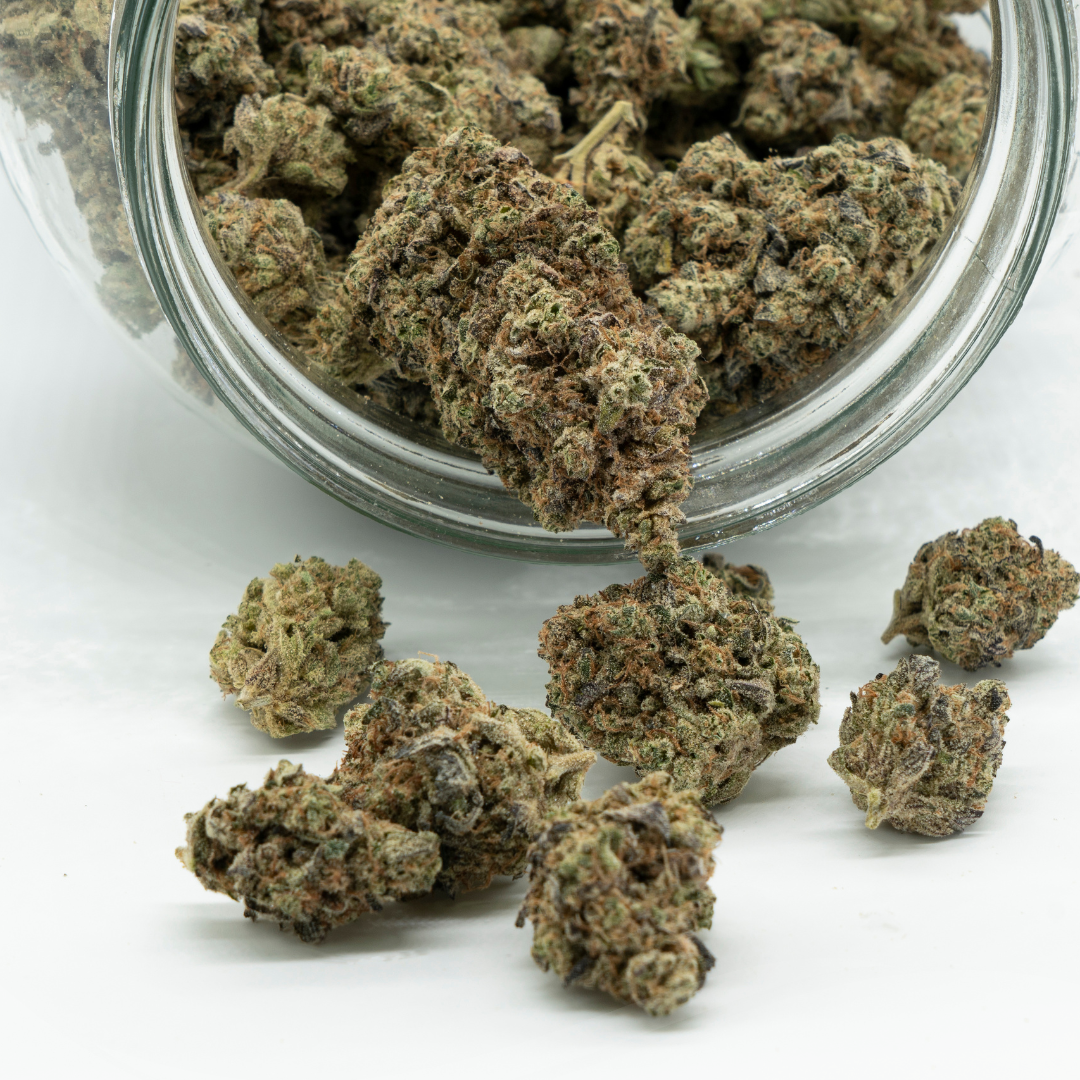
Cannabis & Lung Health
Learn about the BC Lung Foundation’s position on the risks of cannabis use to lung health.
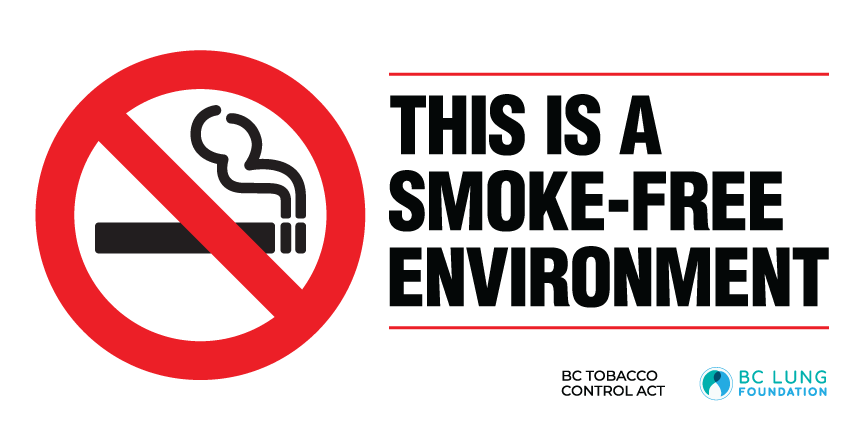
No Smoking Signage
In most jurisdictions across Canada, including British Columbia, smoking is banned in all indoor public places and workplaces, including restaurants and bars.
Questions? Contact Dr. Menn Biagtan, VP, Health Programs & Initiatives: biagtan@bclung.ca

